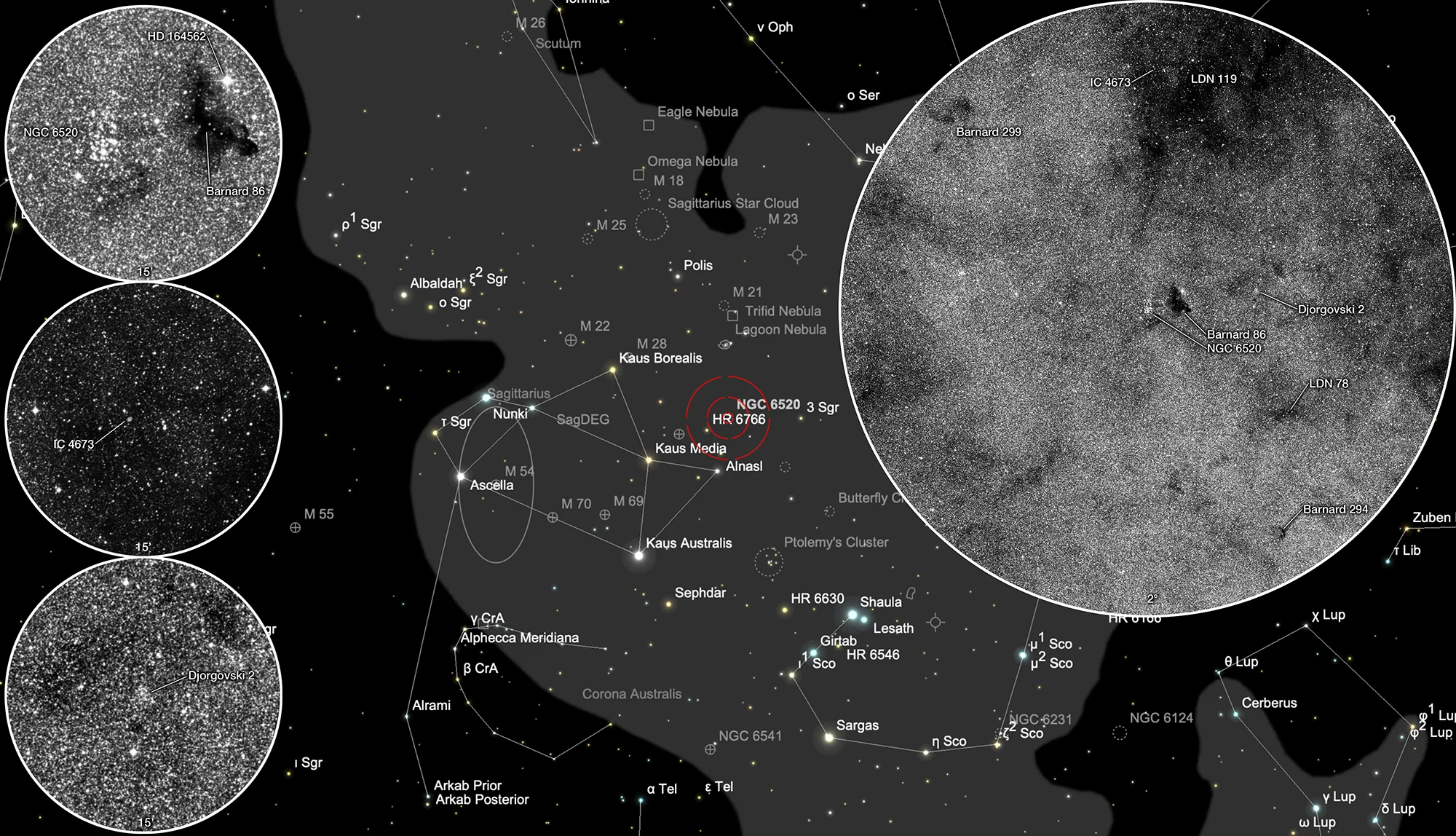Open Cluster NGC 6520 & Ink Spot Nebula Barnard 86

Open Cluster NGC 6520
This open cluster was discovered by William Herschel on 24 May 1784 and listed as VII 7. He noted: «A considerably rich, but pretty coarsely scattered cluster of stars, little more compressed towards the middle.» [463]
| Designation | NGC 6520 |
| Type | OCL (I2m) |
| Right Ascension (J2000.0) | 18h 03m 25.0s |
| Declination (J2000.0) | -27° 53' 28" |
| Diameter | 5 arcmin |
| Visual magnitude | 7.6 mag |
| Metric Distance | 1.577 kpc |
| Dreyer Description | Cl, pS, Ri, lC, st 9…13 |
| Identification, Remarks | WH VII 7; h 3721; GC 4358; OCL 10; ESO 456-SC42 |
Dark Cloud Barnard 86
In 1919 Edward. E. Barnard found on photographs he made a dark cloud near cluster NGC 6520 and listed it as nebula number 86 in his publication «On the Dark Markings of the Sky». He noted: «Diameter 5'; several small stars in it.» [239] In 1962 Beverly T. Lynds published a compilation of 1802 nebula in her «Catalogue of Dark Nebulae» that she found on photo plates of the «National Geographic Palomar Observatory Sky Atlas». This nebula is listed there with the designation LDN 93. [473] A known nickname for this nebula is: «Ink Spot Nebula».
| Name | Barnard 86 |
| Object Type | Dark Cloud (nebula) |
| Right Ascension (J2000.0) | 18h 02m 58s |
| Declination (J2000.0) | -27° 52' 06" |
| Angular size | 5' × 3' |
| Identifiers | Barnard 86; LDN 93; [CB88] 107; [DB2002b] G2.85-2.75 |
Planetary Nebula IC 4673
This planetary was visually discovered by E. E. Barnard on 19 August 1895, while making measures of the diameter of Ceres with the 36-inch Lick refractor. He described it as «round, slightly ill defined, of uniform brightness and no central star. The measured diameter of this object was 13.6". I should class it as being of the 13th magnitude.» [364]

In 1946 the German-American astronomer Rudolph Minkowski identified the planetary nebula M 1-36 with IC 4673 while he was looking for H-α emissions on objective-prism survey plates obtained by W. C. Miller using the 10-inch telescope at Mount Wilson. Further examination of its appearance on direct photographs, taken at the Newtonian focus of the 60-inch or 100-inch telescope on Mount Wilson, revealed its nature as a planetary nebula. [397]
| Designation | IC 4673 |
| Type | PN |
| Right Ascension (J2000.0) | 18h 03m 18.4s |
| Declination (J2000.0) | -27° 06' 22" |
| Diameter | 0.25 arcmin |
| Photographic (blue) magnitude | 12.9 mag |
| Visual magnitude | 13.0 mag |
| Metric Distance | 3.681 kpc |
| Dreyer Description | Planetary, 13 mag, * 13 nf 33" |
| Identification, Remarks | PK 3-2.3; ESO 521-PN15; CS=14.6 |
Globular Cluster Djorgovski 2
The source ESO 456-SC38 was discovered by Holmberg et al. in 1978 and initially classified as an open cluster. In 1987, Stanislav George Djorgovski identified the object as an obscured globular cluster. Consequently, the cluster is often referred to as Djorgovski 2 (or Djorg 2). It is one of the globular clusters closest to the Galactic centre. Similar to the very old inner bulge globular clusters NGC 6522, NGC 6558, and HP 1, Djorgovski 2 appears to be part of the Milky Way's primordial formation stages. [694]

| Identification | Djorg 2 |
| Name | ESO456-SC38 |
| Right Ascension (J2000.0) | 18h 01m 49.1s |
| Declination (J2000.0) | -27° 49' 33" |
| Distance from Sun | 6.3 kpc |
| Distance from Galactic center | 1.8 kpc |
| Metallicity [Fe/H] | -0.65 |
| Weight of mean metallicity | 1 |
| Foreground reddening | 0.94 |
| V magnitude level of the horizontal branch | 17.60 mag |
| Apparent visual distance modulus | 16.90 |
| Integrated V magnitude of the cluster | 9.90 mag |
| Absolute visual magnitude | -7.00 mag |
| King-model central concentration | 1.50 |
| Core radius | 0.33 arcmin |
| Half-light radius | 1.05 arcmin |
| Central surface brightness | 19.50 mag/arcsec2 |
| Central luminosity density | 3.85 |
| Core relaxation time | 107.73 years |
Finder Chart
The open cluster NGC 6520 with the Ink Spot Nebula plus planetary nebula IC 4673 and globular cluster Djorgovski 2 are located in the constellation Sagittarius in a star rich region near the centre of the Milky Way. They are on 23 June in opposition to the Sun. From your location they can best be seen in the months February to November.
Visual Observation
400 mm Aperture: In the 21 mm Ethos eyepiece (85x, 70' field of view) NGC 6520 appears as a nice, small, open star cluster with a prominent ring-shaped chain of stars and a star in its centre. A yellowish-orange star stands slightly to the side. In between, the Ink Spot Nebula Barnard 86 stands out clearly from the brighter background as a triangular, diffuse dark blotch. The small planetary nebula IC 4673 is visible without filter as a small, oval, faint disc. With the 13 mm Ethos eyepiece (138x, 43' field of view), the oval shape of IC 4673 is more clearly recognisable despite some air turbulence. With an O-III filter, the PN remains about the same brightness, while the sky background becomes darker. Although the position of the globular cluster Djorgovski 2 could be clearly determined on the basis of neighbouring stars, the cluster itself remained invisible. — 400 mm f/4.5 Taurus Dobsonian, Falera, 6. 9. 2024, 22:00 CEST, SQM 21.0, Bernd Nies
